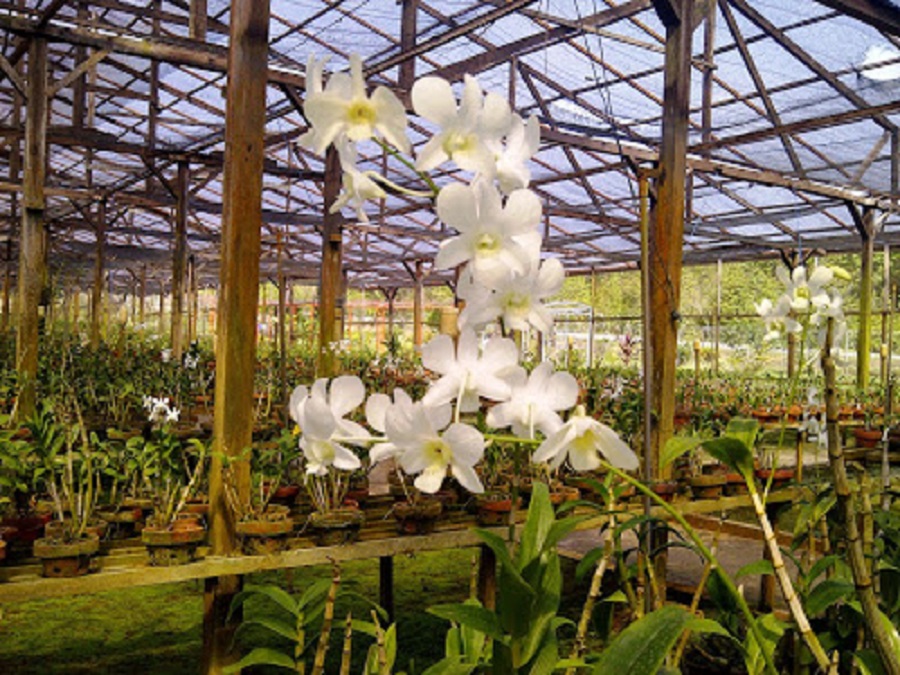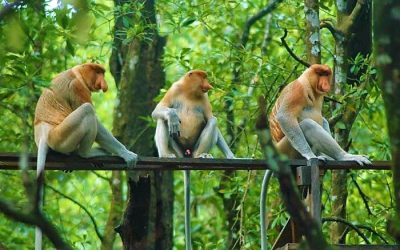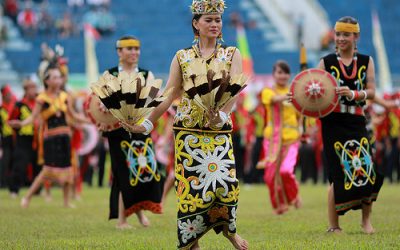Home / Batik Regions – Central Indonesia – Kalimantan Island – North Kalimantan / Orchid Botanical Garden
Natural Destination
Experience the tropical nature!
Orchid Botanical Garden

Vanda Orchid flower (foto: N. Perrault, Wikipedia)

Orchid Botanical Garden (foto: Carletariu)
Orchid Botanical Garden
If you visit Tarakan city, you should go to the Orchid Botanical Garden. It conserves various types of the rarest Kalimantan orchids. You can also find various kinds of mini cactus and beautiful tropical butterflies. This place is definitely awesome for nature lovers.
Tourist Attractions in North Kalimantan
Tarakan Mangrove Forest
Mangrove Forest is one of the favourite tourism sites in Tarakan. We can go along the
Malinau Cultural Festival
You will witness a unique competition that might not be found other than in
Museum of Bulungan Sultanate
Bulungan is a historical museum to witness the legacy of the
North Kalimantan
Batik Motifs
Dayak Taghol
Dayak Taghol has a distinctive style of four curved lines and small dots. This motif represents
Bultiya
The word ‘Bultiya’ is an acronym of the three major tribes in North Kalimantan, namely
Bekantan Pakis
This motif represents Pakis Haji (Polystichum setiferum), an endemic plant in
Discover
Indonesian
Batik
Motifs
Teguh Bersatu
This batik motif shows the strength of the people of Kupang. It also represents a sense of
Hiu Taliyasan
Indonesia is also home to the world’s largest fish, the whale shark (Rhincodon typus). Hiu Taliyasan refers to
Ikan tambal
The word “Ikan” refers to fish. The philosophical meaning of Ikan Tambal means is
Leuit Sijimat
This motif reflects the daily activities of the Baduy tribe in Banten. The main ornaments of batik motif consist of:
Jumputan Bintang
The word Jumputan means the tie-dye technique, while the word “Bintang” refers to
Besurek Rafflesia
The term “Basurek” refers to a textile that contains letters or inscriptions
Awan Berarak
Awan Berarak is a combination of Dayak motifs and Malay patterns. The word ‘Awan Berarak’ means the
Sandeq
Sandeq Boat is a symbol of the maritime importance of the West Sulawesi region. The greatness of
Pohon Hayat (Tree of Life)
The Batik motifs in Lampung are dominated by the acculturation of Buddhist and
La Galigo
La Galigo is a literary work of the Buginese Epic that has 300 thousand epic lines. It is considered even
Bale Lumbu
This motif signifies the welfare of the ancient Sasak society. Bale also symbolizes the
Kaharingan
The Kaharingan or ‘tree of life’ based on the Dayak tribes’ belief system. This tree symbolizes
Kerawang Tegak Aceh
The Vertical Upright (Kerawang Tegak) Motif symbolizes a person who has a strong
Pinawetengan
The Pinawetengan Batik pattern was taken from a prehistoric inscription in
Bekantan Pakis
This motif represents Pakis Haji (Polystichum setiferum), an endemic plant in
Lok Baintan Floating Market
As you can imagine, the most authentic thing is that you can buy things and even
Enggang Dayak
Local people beliefs that hornbills are an incarnation of the Commander of the Birds. It has supernatural
Merak Ngeram
The hatching peacock motif has a very deep meaning which refers to the sacrifice and
Singayaksa
The Singayaksa motif comes from the name of a place where Sultan Hasanuddin used to
Pattimura
Pattimura is the name of an Indonesian hero who fought against colonialism in
Parang Seling
Parang Seling or “alternating daggers” is a royal batik motif. It is a feminine variant of
Gedhog Kembang Waluh
a combination of Javanese cultural motif of the Majapahit kingdom (XII-XIV century) with
Karawo Mahkuta
Mahkuta refers to Gorontalo’s traditional crown. It represents noble characters of
Biji Kopi
The coffee seeds motif illustrates the pride of local coffee specialities in
Burung Bidadari
Bidadari birds are endemic birds in Halmahera. This motif represents an
Gigi Haruan Lidi
The Gigi Haruan Lidi motif is taken from the name of the cork fish and is a symbol of
Wakatobi
It symbolizes the coastal beauty of the Wakatobi island and the symbol of Patra symbolizes
Ukir Sentani
The Ukir motif is a batik motif that is inspired by various traditional Sentani wood carvings
Desa Na Tolu
The Desa Na Tolu characteristic pattern symbolizes the Batak philosophy of existence and
Gonggong Beruntun
This motif illustrates that a person should maintain a positive attitude and
Daun Simpor
This motif is inspired by the Simpor plant (Dillenia Suffruticosa) which is a typical
Tifa Totobuang
The batik motifs illustrate Maluku’s traditional music instrument called
Paqbarre Allo
The word “Barre” means round and “Allo” means the sunlight. This motif is interpreted as
Sekomandi
Its philosophical meaning is the eternal union which refers to a saying “until death do us part”
Tikar Natuna
The Tikar Natuna motif is adapted from the traditional making of pandanus mats in
Tabir Tanjung
Tanjung flower is a type of Cherry tree flower, which is commonly found in
Honai
The Honai is inspired by the traditional house of the Papuan community living in
Salakanagara
Salakanagara batik motif illustrates the first kingdom in the Betawi land
Tenun Bima
The motifs are adopted from Bima woven textile. This pattern has received a great
Ake Patra
Ake is related to the divinity and the composition of the universe. It is a symbol of
Gentala Arasy
Built as high as 80 meters, the tower also highlights the historical side of
Kuda Kupang
Horses symbolize wealth. It contains noble values of virtuous characters that bring
Bultiya
The word ‘Bultiya’ is an acronym of the three major tribes in North Kalimantan, namely
Dayak Kamang
Kamang motif is generally found in the Dayak tribe shield because it is believed to
Rangkiang
The word “Rangkiang” refers to the rice granary in the Minangkabau language. It symbolizes
Tangerang Herang
Tangerang Herang motif is a symbol of Tangerang city. The Tangerang Herang batik motif consists of
Buketan Bali
The Balinese bouquet (Buketan Bali) is a floral arrangement and the name is
Bomba Mawar
This motif means sacred love for family, kingdom, and God; It also illustrates
Parang Rusak
Another meaning behind this motif is an unconquerable spirit, symbolized by
Kain Cual
Cual textile tradition has existed since the 17th century. The word “Cual” refers to
Prada Papua
The word “Prada” in the Javanese-Indonesian dialect means a batik textile that
Daun Sirih
This motif illustrates betel leaves that are used by Lombok communities as traditional
Gorga Simeol-Meol
The Gorga Simeol-meol is a pattern of plant tendrils. it is regarded as a symbol of longevity and
Tampuk Manggis Sasirangan
The motif illustrates the philosophy of the mangosteen fruit, which is
Pucuk Rebung Riau
Pucuk Rebung symbolizes heart determination in achieving goals, good luck, and
Daun Lada Hitam
The black pepper motif represents the main commodity of Bangka Belitung
Kasih Tak Sampai
‘Kasih Tak Sampai’ is an idiom in the Indonesian language which refers to
Durian Pecah
Broken Durian motifs depict the foundation of faith. The second half signifies the mastery of
Sekar Jati
Sekar means flower and Jati refers to teak trees that symbolizes a strong mental character that
Wirasat
Wirasat or divine inspiration is a gift from God. This inspiration is symbolized by
Karawo Pinang
Pinang refers to the Palm areca tree. This motif is considered as the original
Insang Ikan
Insang refers to the gills of the fish. This is a typical pattern of Malay ethnic who inhabits
Malinau Cultural Festival
You will witness a unique competition that might not be found other than in
Dayak Taghol
Dayak Taghol has a distinctive style of four curved lines and small dots. This motif represents
Gajah Way Kambas
The motif illustrates the Lampung’s natural reserve, the Way Kambas. it also symbolizes
Mahkota Siger
Siger is the crown of a noblewoman in ancient time. It is a symbol of femininity, strength, and
Cengkeh
The clove flower motif is the main commodity of the Tolitoli Regency. This motif represents
Tubo Kelapa
Coconut tree is a symbol of a good character and strong mentality. It illustrates the more success a person, the more
Gamolan
This motif illustrates Gamolan, a bamboo musical instrument of Lampung that is
Lontara
The Lontara script itself is a typical ancient script of Bugis and Makassar communities. History records that
Keluak Daun Pakis
The word “Keluak” is a Minang language which means twisted or tangled. The Motif of
Kaganga Tanah Rejang
If Batik Besurek combines Arabic calligraphy motifs, then the Kaganga batik takes
Gurdo Solo
Gurdo or garuda bird is the mount of the Indian god Vishnu. As the Sun Bird,



